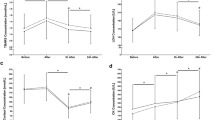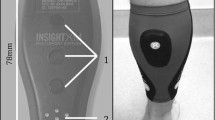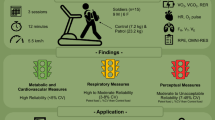Abstract
Thirteen healthy Labrador retrievers underwent a 5-stage incremental treadmill exercise test to assess its reliability. Blood lactate (BL), heart rate (HR), and body temperature (BT) were measured at rest, after each stage of exercise, and after a 20-min recovery. Reproducibility was assessed by repeating the test after 7 days. Two-way MANOVAs revealed significant differences between consecutive stages, and between values at rest and after recovery. There was also a significant reduction in physiological strain between the first and second trial (learning effect). Test reliability expressed as typical error (BL = 0.22 mmol/l, HR = 9.81 bpm, BT = 0.22°C), coefficient of variation (BL = 19.3%, HR = 7.9% and BT = 0.6%) and test–retest correlation (BL = 0.89, HR = 0.96, BT = 0.95) was good. Results support test reproducibility although the learning effect needs to be controlled when investigating the exercise-related problems commonly observed in this breed.

Similar content being viewed by others
Notes
Study protocol 0705A07843, approved on June 20 2007.
L8 Rehabilitation Treadmill, Landice Inc., Randolph, New Jersey USA.
Web Master™, Ruff Wear Inc., Bend, Oregon, USA.
Bark'n Boots™ Grip Trex™, Ruff Wear Inc., Bend, Oregon, USA.
Lactate Scout, Senslab, Leipzig, Germany.
Sapphire ECG, Vetronic, Newton Abbot, UK.
Blue sensor, M-00-S, Medicotest, Ølstykke, Denmark.
Mabis Healthcare, Waukegan, Illinois, USA.
SPSS 16.0 Software, Chicago, Illinois, USA.
Microsoft Office Excel XP 2003, Microsoft Corporation, US.
References
Allen DG, Lamb GD, Westerblad H (2008) Skeletal muscle fatigue: cellular mechanisms. Physiol Rev 88:287–332
Arai Y, Saul JP, Albrecht P, Hartley LH, Lilly LS, Cohen RJ, Colucci WS (1989) Modulation of cardiac autonomic activity during and immediately after exercise. Am J Physiol 256:H132–H141
Davis JA, Vodak P, Wilmore JH, Vodak J, Kurtz P (1976) Anaerobic threshold and maximal aerobic power for three modes of exercise. J Appl Physiol 41:544–550
Dodd S, Powers SK, Callender T, Brooks E (1984) Blood lactate disappearance at various intensities of recovery exercise. J Appl Physiol 57:1462–1465
Ferasin L, Marcora S (2007) A pilot study to assess the feasibility of a submaximal exercise test to measure individual response to cardiac medication in dogs with acquired heart failure. Vet Res Commun 31:725–737
Ferasin L, Faena M, Henderson SM, Langford K, Darke PG (2005) Use of a multi-stage exercise test to assess the responsiveness of rate-adaptive pacemakers in dogs. J Small Anim Pract 46:115–120
Ferasin L, Dodkin SJ, Amodio A, Murray JK, Papasouliotis K (2007) Evaluation of a portable lactate analyzer (Lactate Scout) in dogs. Vet Clin Pathol 36:36–39
Gandevia SC (2001) Spinal and supraspinal factors in human muscle fatigue. Physiol Rev 81:1725–1789
Gandevia SC, Taylor JL, Butler JE (2000) Stopping exercise: role of pulmonary C fibers and inhibition of motoneurons. News Physiol Sci 15:241–245
Gladden LB (2004) Lactate metabolism: a new paradigm for the third millennium. J Physiol 558:5–30
Hinchcliff KW, Olson J, Crusberg C, Kenyon J, Long R, Royle W, Weber W, Burr J (1993) Serum biochemical changes in dogs competing in a long-distance sled race. J Am Vet Med Assoc 202:401–405
Hopkins WG (2000) Measures of reliability in sports medicine and science. Sports Med 30:1–15
Ilkiw JE, Davis PE, Church DB (1989) Hematologic, biochemical, blood-gas, and acid-base values in greyhounds before and after exercise. Am J Vet Res 50:583–586
Kittleson MD, Johnson LE, Pion PD (1996) Submaximal exercise testing using lactate threshold and venous oxygen tension as endpoints in normal dogs and in dogs with heart failure. J Vet Intern Med 10:21–27
Levick JR (2003) An introduction to cardiovascular physiology. Arnold, New York
Matwichuk CL, Taylor S, Shmon CL, Kass PH, Shelton GD (1999) Changes in rectal temperature and hematologic, biochemical, blood gas, and acid-base values in healthy Labrador retrievers before and after strenuous exercise. Am J Vet Res 60:88–92
McArdle WD, Katch FI, Katch VL (2000) Essentials of exercise physiology. Lippincott Williams and Wilkins, Philadelphia
McGawley K, Bishop D (2006) Reliability of a 5 × 6-s maximal cycling repeated-sprint test in trained female team-sport athletes. Eur J Appl Physiol 98:383–393
Messonnier L, Freund H, Denis C, Feasson L, Lacour JR (2006) Effects of training on lactate kinetics parameters and their influence on short high-intensity exercise performance. Int J Sports Med 27:60–66
Messonnier L, Kristensen M, Juel C, Denis C (2007) Importance of pH regulation and lactate/H+ transport capacity for work production during supramaximal exercise in humans. J Appl Physiol 102:1936–1944
Ordway GA, Floyd DL, Longhurst JC, Mitchell JH (1984) Oxygen consumption and hemodynamic responses during graded treadmill exercise in the dog. J Appl Physiol 57:601–607
Pierpont GL, Stolpman DR, Gornick CC (2000) Heart rate recovery post-exercise as an index of parasympathetic activity. J Auton Nerv Syst 80:169–174
Saunders PU, Pyne DB, Telford RD, Hawley JA (2004) Reliability and variability of running economy in elite distance runners. Med Sci Sports Exerc 36:1972–1976
Sjodin B, Jacobs I (1981) Onset of blood lactate accumulation and marathon running performance. Int J Sports Med 2:23–26
Stamford BA, Moffatt RJ, Weltman A, Maldonado C, Curtis M (1978) Blood lactate disappearance after supramaximal one-legged exercise. J Appl Physiol 45:244–248
Steiss J, Ahmad HA, Cooper P, Ledford C (2004) Physiologic responses in healthy Labrador retrievers during field trial training and competition. J Vet Intern Med 18:147–151
Svedahl K, MacIntosh BR (2003) Anaerobic threshold: the concept and methods of measurement. Can J Appl Physiol 28:299–323
Taylor SM, Shmon CL, Shelton GD, Patterson EN, Minor K, Mickelson JR (2008) Exercise-induced collapse of Labrador retrievers: survey results and preliminary investigation of heritability. J Am Anim Hosp Assoc 44:295–301
Tokmakidis SP, Leger LA, Pilianidis TC (1998) Failure to obtain a unique threshold on the blood lactate concentration curve during exercise. Eur J Appl Physiol Occup Physiol 77:333–342
Wikipedia (2009) List of most popular dog breeds
Yoshida T, Chida M, Ichioka M, Suda Y (1987) Blood lactate parameters related to aerobic capacity and endurance performance. Eur J Appl Physiol Occup Physiol 56:7–11
Acknowledgments
We would like to thank all the owners of the dogs involved in this study for their precious support and encouragement. A special thank you to Heidi Cooper, Jaime Shriver and Christopher McKinney for their invaluable technical assistance. Some of the results of the present study have been presented at the ECVIM-CA annual congress, Ghent, Belgium, 4–8 September 2008. This study was supported by the Department of Clinical Veterinary Sciences, University of Minnesota, USA.
Author information
Authors and Affiliations
Corresponding author
Additional information
Communicated by G. Heldmaier.
Rights and permissions
About this article
Cite this article
Ferasin, L., Marcora, S. Reliability of an incremental exercise test to evaluate acute blood lactate, heart rate and body temperature responses in Labrador retrievers. J Comp Physiol B 179, 839–845 (2009). https://doi.org/10.1007/s00360-009-0367-z
Received:
Revised:
Accepted:
Published:
Issue Date:
DOI: https://doi.org/10.1007/s00360-009-0367-z




